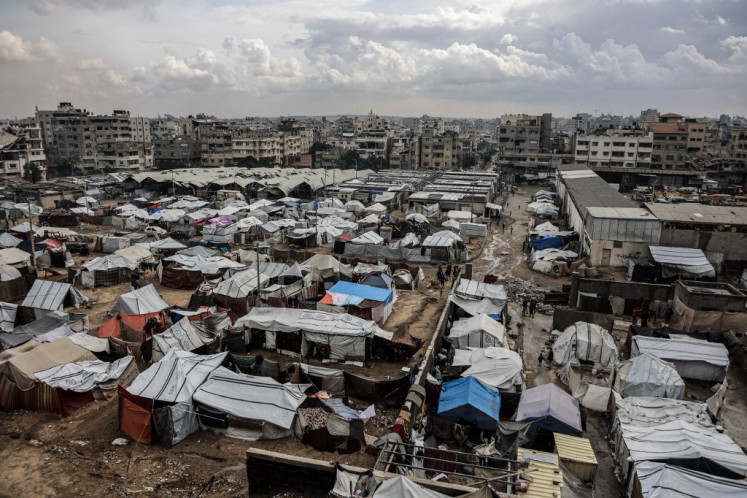Popular Reads
Top Results
Can't find what you're looking for?
View all search resultsPopular Reads
Top Results
Can't find what you're looking for?
View all search resultsAn invitation from Lombok
Give and take: Tourism helps keep Lombok’s cultural traditions, such as handicrafts, alive
Change text size
Gift Premium Articles
to Anyone
Give and take: Tourism helps keep Lombok’s cultural traditions, such as handicrafts, alive.
Driving along Lombok’s new main roads is like sailing over black silk.
From tourist center Senggigi to the fishing district of Permenang, recent infrastructure investment has created one of the finest stretches of road imaginable.
Soaring high above black- and white-sand beaches, the road winds along Lombok’s northwest coast in glorious turns, twisting through harbors and bays, around breathless hairpin bends to the inlets below.
This 54-kilometer-long road ensures the continuation of the annual Lombok Triathlon, while also benefiting local farmers freighting produce to markets, and making Lombok an attractive side trip to the Gili islands.
Road infrastructure is part of the West Nusa Tenggara administration’s commitment to expanding tourism in Lombok and Sumbawa, with investment from both local and central governments.
Lombok has – in tourism terms – long been Bali’s poor cousin, but that may all change from Sunday July 5, when the province launched its “Visit Lombok and Sumbawa 2012” promotional campaign.
While Bali’s tourism crown grows tarnished under collapsing infrastructure of deeply potted roads, break-a-leg gaping holes in footpaths, coupled with a compromised environment of plastic clogged rivers, rubbish dumps sprouting on every available inch of ground and newly introduced rabies. West Nusa Tenggara (NTB) is stepping up to the plate and targeting one million visitors to Lombok per year by 2012: And laying down the foundations, and the bucks, to make it happen.
Currently the province has 500,000 visitors annually, but with a new international airport, improved road network and the stabilizing of an adequate electricity supply, it is realistic to target such a growth of visitors, explains the director of the culture and tourism office, Lalu
Gita Ariadi.
“Next year, in 2010, the international airport will be operational, so we can have direct flights from Europe, the Middle East and Japan,” said Ariadi.
“[Japanese] visitors have to fly over NTB and then come back to Lombok, so they stay in Bali,”
Opening the new airport is one hurdle – a greater challenge will be making flights to the island affordable.
“We currently have three direct flights a week from Singapore to the existing airport. We will
heavily promote the area in the Singaporean and Malaysian markets. This is Lombok’s front verandah,” said Ariadi.
Opening direct flights to Malaysia will benefit tourism and improve travel for overseas workers, Ariadi explained, pointing out the administration’s tourism drive was designed to benefit its citizens, as seen in the employment opportunities for citizens of Lombok and Sumbawa offered by the road construction.
Safe harbor: Lombok’s Lembar Harbor, with its multiple docks, welcomes international passenger ships.
To date, more than 7,000 NTB residents have been employed on infrastructure projects, with further employment growth expected with more projects on the horizon, said Ariadi. This escalation in employment has a direct impact on poverty reduction, he added.
The NTB government believes that as the number of visitors to Lombok grows, there will be a spillover to Sumbawa, where a new road development project will ensure access across NTB’s largest island.
“The roads there [Sumbawa] still have potholes, but by 2010 they will be perfect,” said Ariadi.
Tourism offers benefits to the local community, Ariadi stresses. He points to the resolution of tensions surrounding the international airport in Tanah Awu, Central Lombok, tensions he says markedly quietened down with employment.
“The first step for the airport was to grow a sense that [infrastructure] belongs to the people, will offer them something valuable in the future. We are seeing pride develop, there is a sense of ownership in the project through greater employment,” said Ariadi. That benefit is witnessed by warung owners. “Kuta [southern Lombok] was pretty dangerous in the past, but things are better now. People have work and can feed their families,” said a warung owner in West Lombok, adding that in the past he advised people not to travel into the region after dark.
Ariadi admits to former difficulties. “We have had problems in the past, but our culture is to respect guests, to make people feel welcome. That is inherent in our ancient culture.” he said.
“We want to be on a road of growth that helps our people. We want to see local content [in tourism], not only rock and roll, but also the music and culture of NTB. We are working on how to have tourism work in harmony with the conservation of our culture.”
Eco and cultural tourism are at the head of NTB’s tourism push, said Ariadi, aware of how tourism can damage both landscapes and cultures if it is not carefully orchestrated.
“For 30 years we have studied tourism. It started here in 1984, but has been up and down. To protect our culture and environment [from tourism growth] we have studied problems in other areas and want to see a steady upward growth of tourism.
“Lombok runs from the sea to the mountains, so where Sulawesi was home to the World Oceans Conference, we are of the land,” said Ariadi, adding the government aims to host a World Eco-tourism Conference in the future.
The NTB administration’s commitment to tourism does not end at roads, airports and electrical supplies; it is currently seeking investment partners for a Rp 20 trillion hotel complex on 505 hectares of government land in Kuta, the building of a convention center in Mataram and upgrades to the International Security Board Certificated Lembar Harbor to increase passenger cruise-ship visits.
Working alongside tourism infrastructure investment is the NTB administration’s commitment to growing human resources via education and job training.
“There is a problem with education. That needs to be upgraded. In the future we would like to see greater education and employment,” said Ariadi.
“The administration can’t do this alone. We need to work with the people to achieve this.”
— Photos by J.B. Djwan











